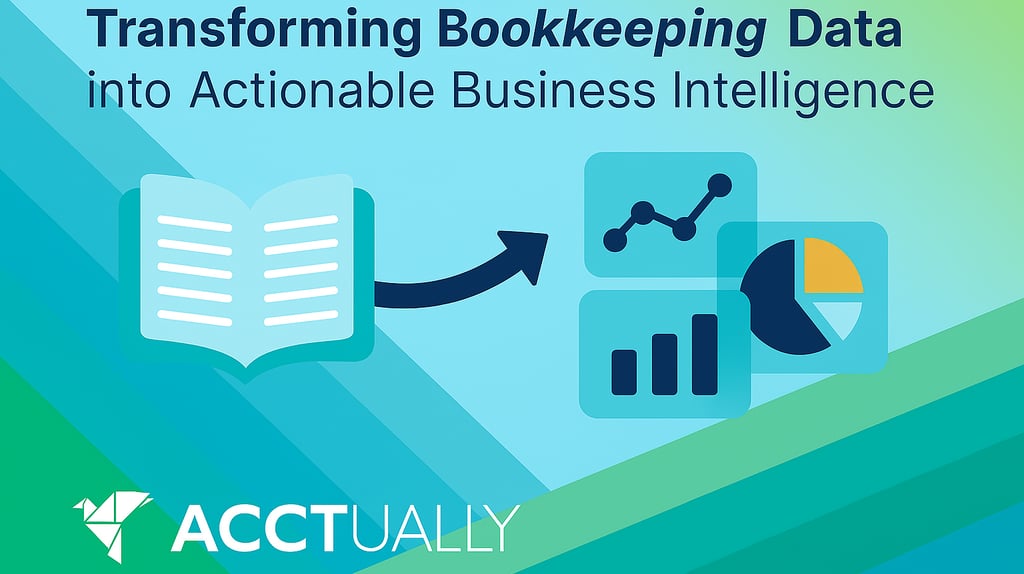Transforming Bookkeeping Data into Actionable Business Intelligence
Most business owners see bookkeeping as a compliance task—but your financial data holds the key to smarter, faster decisions. This guide from Acctually explains how to transform your books into actionable business intelligence, identify the right metrics, and use real-time insights to drive profitability.


How to Turn Your Bookkeeping Data Into Business Intelligence
Bookkeeping is often viewed as a task of keeping records straight — something to manage for taxes or compliance. But your books can do much more than that. When organized and analyzed effectively, they can serve as a powerful decision-making tool for your business.
Turning bookkeeping data into business intelligence helps you see what’s driving your success, where money might be slipping away, and what changes can lead to more sustainable growth.
Here’s how to make your numbers work for you.
1. Go Beyond Basic Recordkeeping
Accurate bookkeeping is the foundation of any meaningful analysis. To get started:
Categorize income and expenses consistently.
Reconcile your accounts regularly.
Tie financial data to key operational details like customers, projects, or departments.
This level of detail transforms your books from simple records into a system that can generate insights about how your business truly performs.
2. Identify Metrics That Matter
Not every number in your books deserves equal attention. Focus on a few key metrics that actually move the needle for your business, such as:
Gross Profit Margin: How efficiently your business delivers its product or service.
Operating Expenses: Where spending is creeping up or staying in control.
Cash Flow: How much flexibility you have for investments or unexpected costs.
Customer or Product Profitability: Which areas are generating the most value.
These metrics give you a clear picture of financial health and help you make informed decisions.
3. Visualize Your Data
Numbers in spreadsheets can be hard to interpret. Visual dashboards make data easier to digest and act on.
Tools like Fathom, Spotlight Reporting, or Google Looker Studio connect directly to your accounting system and display key insights such as:
Revenue trends
Cash flow forecasts
Budget versus actual performance
When you can see your financial story at a glance, it’s easier to identify patterns, risks, and opportunities.
4. Connect Financial and Operational Data
Your books are only part of the story. Integrating your accounting system with operational tools — like your CRM, project tracker, or inventory software — helps you understand how business activities drive financial outcomes.
For example:
How marketing spend affects new client revenue
How project timelines impact cash flow
How inventory turnover influences margins
These connections turn data into context — and context drives better decisions.
5. Make It a Habit to Review and Reflect
Data only matters if it’s reviewed regularly. Set aside time each month to:
Compare performance against targets or budgets
Identify variances and their root causes
Adjust priorities or spending based on what the data shows
Making financial review part of your routine ensures you’re always managing proactively, not reactively.
Turning Numbers Into Strategy
Bookkeeping isn’t just about compliance — it’s about clarity. With the right structure, analysis, and habits, your financial data becomes a reliable guide for smarter decisions and long-term growth.
Don’t know where to start? Books a mess? Give us a call.
At Acctually, we help businesses organize, interpret, and leverage their financial data so owners can make confident, informed decisions every step of the way.
👉 Schedule a quick consultation to see how better bookkeeping can lead to better business intelligence.
📧 Email us at hello@acctually.com
🌐 Visit us at https://acctually.com/
📞 Call us at (646) 543-4916
